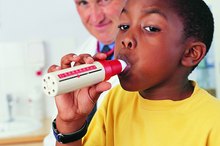What does fact checked mean?
At Healthfully, we strive to deliver objective content that is accurate and up-to-date. Our team periodically reviews articles in order to ensure content quality. The sources cited below consist of evidence from peer-reviewed journals, prominent medical organizations, academic associations, and government data.
The information contained on this site is for informational purposes only, and should not be used as a substitute for the advice of a professional health care provider. Please check with the appropriate physician regarding health questions and concerns. Although we strive to deliver accurate and up-to-date information, no guarantee to that effect is made.
Airlife Spirometer Instructions
**An incentive volumetric spirometer is a breathing therapy tool primarily used following surgery to keep the lungs active and reduce the incidence of pneumonia, pneumothorax and a permanent decrease in lung tissue function 1.
If you are experiencing serious medical symptoms, seek emergency treatment immediately.
** The Airlife Incentive Spirometer contains an easily adjustable patient goal indicator that encourages patients to be actively involved in their own recovery process 1.
The Airlife Spirometer has either a 2500 or 4000 milliliter air volume capacity, and a coaching indicator to let users know if they are breathing too fast or too slow. The Airlife brand also has brightly colored versions intended for pediatric use.
Sit up as straight as possible. Sitting up straight allows your lungs to expand fully. Do not force yourself into a fully upright position if you are not able to immediately following surgery.
Collapsed Lung Exercises
Learn More
Grip the handle of the Airlife Spirometer with your left hand so that the spirometer is upright and the numbers and goal indicator (small plastic arrow) are facing toward you.
Insert the end of the air hose into the hole located on the front, right side of the spirometer. The air hose is a clear or blue hose with a crimped appearance. The hose will have a mouthpiece attached at one end.
Breathing Exercises After Heart Surgery
Learn More
Insert the end of the mouthpiece into your mouth. Form a tight seal around the mouthpiece with your lips. In order to accurately calculate the volume of inspired air it is important to keep a tight seal intact.
Inhale deeply and slowly. Watch the coaching ball right above the air tubing. The ball should remain in the center of the indicator for the duration of the breath. Inhaling too quickly will force the ball to the top of the indicator and breathing too slowly will allow the ball to drop to the bottom of the indicator. Breathing slowly is important as it allows the alveoli or air sacs within your lungs to fully expand. You will feel some resistance as you perform this task. The sensation is much like drinking through a straw.
Watch the piston in the numbered chamber begin to rise as you inhale. The piston will move up to a number, which indicates the volume of air you have inhaled.
Slide the goal indicator to the highest point the piston reaches. The indicator helps you to remember the volume of air you have achieved. You may also set the goal indicator to reflect an overall goal set by your health care provider. You should not be concerned if you are not able to achieve high numbers immediately following surgery. This is especially true if the surgery involves an area on your chest.
Hold your breath in for as long as possible -- at least five seconds is preferable. Allow the piston to fall back down into the resting position.
Remove the mouthpiece from your mouth and slowly exhale.
Take five to ten normal breaths. These breaths are an important part of the exercise because they allow your lungs to get a break. This step will also help to prevent you from becoming dizzy or lightheaded.
Cough to allow any lung secretions to be forced out of the lungs. This step is important in preventing infections such as pneumonia from forming. It can also help to improve your air volume numbers because decreased secretions will open more lung surface area.
Repeat this process up to 10 times in one hour or as many times as instructed by your health care provider. Use a pillow to splint your stomach and chest if that was the area included in recent surgery.
Warnings
Take a break from the exercises if you feel lightheaded, or short of breath.
Related Articles
References
- Cleveland Clinic: How To Use an Incentive Spirometer
- Cleveland Clinic. Incentive Spirometer. Updated May 2, 2018.
- Eltorai AEM, Baird GL, Eltorai AS, et al. Perspectives on Incentive Spirometry Utility and Patient Protocols. Respiratory Care. 2018;63(5):519-531. doi:10.4187/respcare.05872.
- Kenny J-ES, Kuschner WG. Pneumothorax Caused by Aggressive Use of an Incentive Spirometer in a Patient With Emphysema. Respiratory Care. 2012;58(7). doi:10.4187/respcare.02130.
- Liu C-J, Tsai W-C, Chu C-C, Muo C-H, Chung W-S. Is incentive spirometry beneficial for patients with lung cancer receiving video-assisted thoracic surgery? BMC Pulmonary Medicine. 2019;19(1). doi:10.1186/s12890-019-0885-8
Writer Bio
Amanda Goldfarb became a freelance writer in 2006. She has written many articles for "Oviedo TRI-Lights," "Cool Runnings" and several other health- and fitness-related blogs. She has also contributed to her town's tri-club newsletter. Goldfarb obtained her Bachelor of Arts degree in English from the University of Central Florida and is currently pursuing a degree in emergency medical services.









